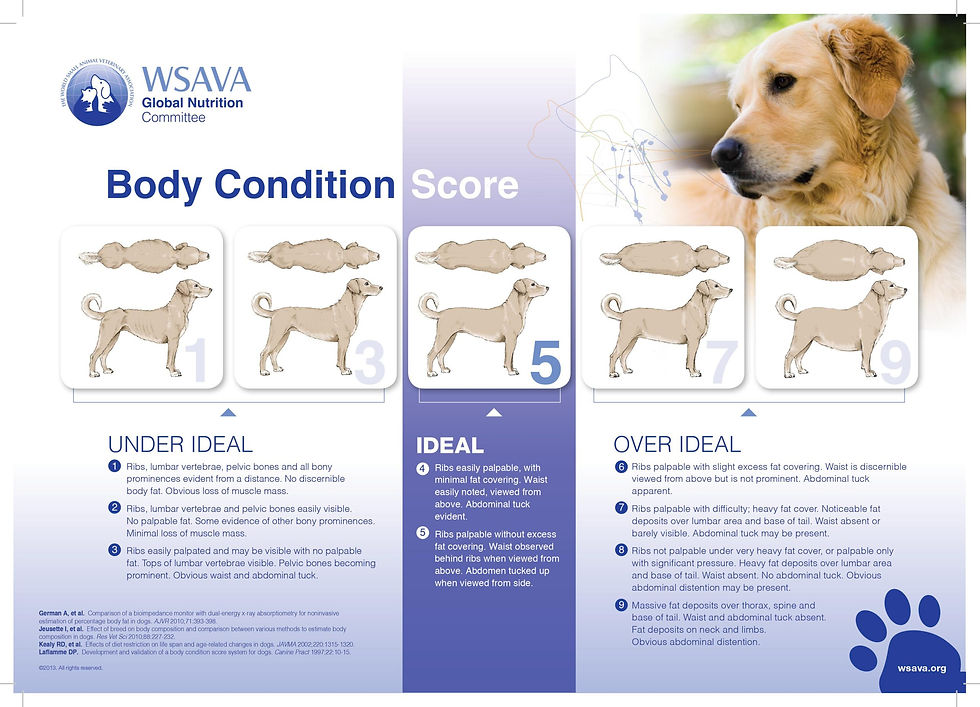Is My Pet Fat?: Addressing Obesity in Dogs and Cats
- Kendra Gray, CPDT-KA

- Oct 20, 2023
- 4 min read
Updated: Jun 11, 2024
Has your pup gotten a little too pudgy? Is your kitty carrying some extra pounds? Humans aren’t the only ones battling the bulge, statistics show our pets are facing an epidemic of obesity right alongside us. While portly pooches and plump pussycats may seem extra squishy and adorable, the excess pounds can be a real danger when it comes to the development of obesity-related health issues. Excess weight on your dog or cat can lead to medical conditions like arthritis, heart disease, diabetes, and even a shortened lifespan.

As of 2023, the majority of pets in the United States — 59% of dogs and 63% of cats were classified as overweight or obese. And, just as with humans, the extra pounds on our furry companions tend to creep up over time, making it more challenging for pet owners to notice. Detecting if your pet is overweight is crucial to their health and well-being.
Here are some signs to look out for:
Visible Weight Gain. The most obvious sign is a noticeable increase in your pet’s weight. Beyond numbers on a scale, you should be able to feel your pet’s ribs by gently running the flat of your palm across the sides of their chest. According to the American Kennel Club (AKC), if you need to press firmly or can’t feel the ribs at all, your dog or cat likely has too much fat. From above, you should see a defined waist toward the rear and a straight build down the sides, and from the side, a slightly raised or tucked waist.
Difficulty Walking or Running. If your pet struggles to engage in physical activities they once enjoyed, it could be due to excess weight.
Breathing Problems. Overweight pets may pant excessively even after minimal exertion, which can be a sign of respiratory distress.
Increased Fat Pockets or Pads. Excess fat deposits on your pet’s body are an indicator that they are likely overweight. Look for fat deposits around the base of the tail, fat sacks between their legs that may waddle when your dog or cat walks, and fat pads along the top of your dog’s hips.
Lethargy. An overweight pet is often less active and may seem lethargic compared to their healthy-weight counterparts.
Difficulty Grooming. Cats, in particular, may have trouble grooming themselves due to excess weight, leading to a dull or unkept coat.
Collar Tightness. If you notice that your pet’s collar has become a bit snug or downright tight, it could be a sign of weight gain.
You or your veterinarian may also choose to perform an assessment using a Body Condition Score (BCS) system, which ranks pets on a scale from 1 (emaciated) to 9 (obese). A 4-5 reflects an ideal body weight. BCS charts, like the ones below from the World Small Animal Veterinary Association (WSAVA), are an excellent tool for vets, as well as pet owners, to determine a dog or cat’s healthy weight. Once your pet’s ideal weight is determined, your vet can help you create a plan to maintain or decrease your pet’s weight by targeting caloric intake and exercise.
Similar to human diets, any weight loss plan for your pet will likely focus on diet, exercise, moderation, and monitoring.
Balanced Diet. Ensure your pet is receiving the right amount of high-quality balanced pet food. You may be unintentionally overfeeding your dog or cat if you are following the portion size instructions provided by the pet food manufacturer. Portion sizes on pet food packaging are often generalizations that do not reflect individual animal needs. If you are unsure about brand or portion size, check with your vet for suggestions.
Regular Exercise. Engage your pet in regular physical activities appropriate for their breed and age. Playtime, interactive toys, and walking are all excellent ways to keep your pet moving and burning extra fat and calories. If your schedule makes regular walks with your dog difficult or frequent playtime with your cat a challenge, reach out to a walking service like Daily Leash and let them take the lead on keeping your pets active.
Treats in Moderation. There’s no question that treats provide excellent motivation, and many humans and animals consider food one of their love languages. But treats have added calories, so if you’re watching your pet’s weight it’s a good idea to limit the number you dole out and avoid using them as your primary source of affection. As a general rule, you should aim for your dog or cat to get no more than 10% of their daily caloric intake from treats. You can counteract the dreaded cookie calories by using your pet’s kibble as treats and feeding part of their meal to them throughout the day or, you may consider substituting healthy, low-calorie snacks like fruit or steamed or raw vegetables that are safe for dogs (carrots, blue berries, green beans, cucumbers, etc).
Weight Monitoring. Just as it is with humans, the road to weight loss for your pet can seem daunting. It is a process and the only real way to see progress is through tracking. Regularly weigh your pet and reassess their body condition using the tools above. This will allow you to adjust their diet and exercise routine as necessary and stay on track for a healthy future.
Maintaining a healthy weight is essential to your pet’s overall well-being. By recognizing the signs of excess weight in pets and taking proactive steps to manage their weight, you can ensure that your four-legged family member enjoys a long, happy, and healthy life.
Note: Always consult with your veterinarian for personalized guidance.






Comments